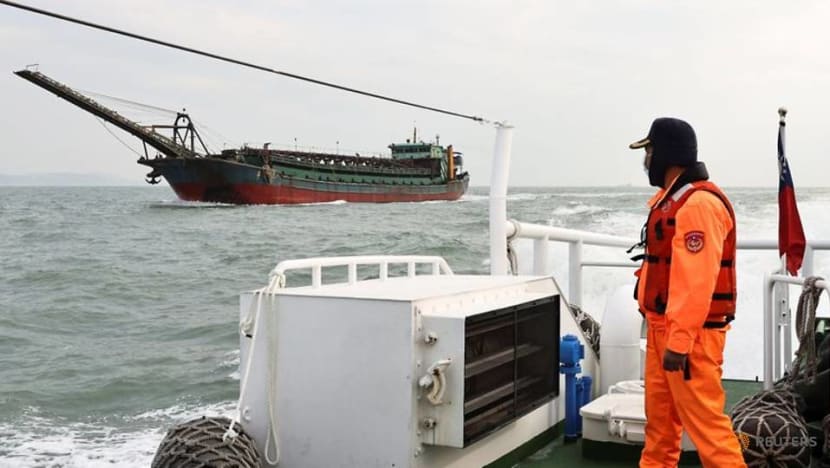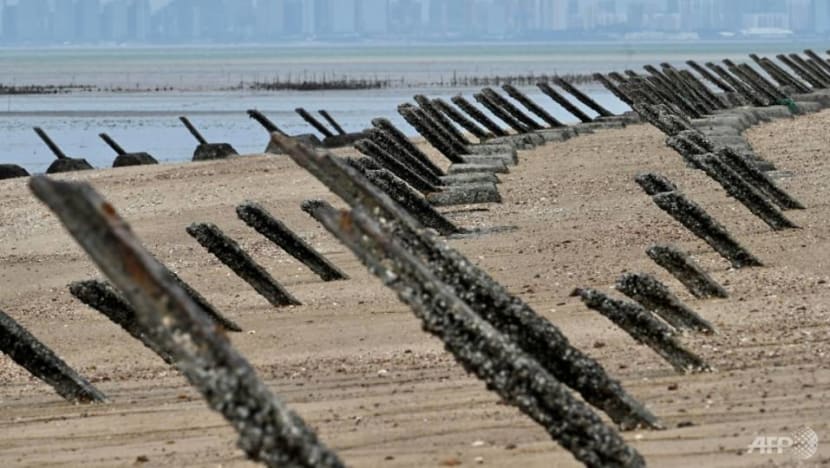commentary Commentary
Commentary: China is in no position to take Taiwan by force
Unlike his predecessors, Chinese President Xi Jinping has demonstrated greater intensity in the desire for reunification, says Cui Lei from the China Institute of International Studies.

A H-6 bomber of the Chinese People's Liberation Army Air Force flying near a Taiwan F-16 in a Feb 10, 2020 handout photo. (Photo: Reuters)
BEIJING: The situation across the Taiwan Strait has seemed to be on the brink of crisis since 2018.
Beijing has sent numerous sorties of military aircraft to conduct exercises near Taiwan and frequently crossed the median line of the Taiwan Strait.
It has been rumoured that the mainland is considering seizing Taiwan’s outlying islands, suggesting that it is increasingly eager to take Taiwan by force.
With the exception of missile exercises during Taiwan’s first direct presidential election in 1996, Beijing has historically been restrained in its military intimidation, choosing to vent its anger through rhetoric or symbolic sanctions.
WHY CHINA APPEARS MORE ASSERTIVE?
Its recent assertiveness is best explained by its rising military power status and stronger expressions of motivation for reunification.
Improved amphibious warfare and anti-access or area denial capabilities mean the military balance is tipping in the mainland’s favour over Taiwan and the United States.
With increasing national strength, the Chinese leadership believes that continuing to adopt softer policies as it had in the past may give the impression of weakness to both domestic and foreign audiences.
READ: Commentary: Major countries are concerned about implications of China's rise. So is China
Unlike his predecessors, Chinese President Xi Jinping has demonstrated greater intensity in the desire for reunification.
The report of the 19th National Congress of the Chinese Communist Party (CCP) in 2017 demonstrated this enthusiasm, announcing the “great rejuvenation” of the Chinese nation needs to be achieved by 2049, and that the reunification of China is a condition for that.
DOMESTIC POLITICAL COST
But the mainland unlikely has any intention to pursue reunification by force anytime soon.

One reason is that the domestic political risks are high if the use of force is not successful.
Victory is not yet a forgone conclusion — having prepared for conflict with the mainland for decades, Taiwan has toughened its ability to defend itself. Taiwan’s will is strong. Polls show that 80 per cent of Taiwanese people are willing to defend the island by force.
In the context of the 20th Party Congress in 2022 in particular, Xi needs a stable domestic political environment to ensure the extension of his term as General Secretary of the CCP.
READ: Commentary: Taiwan is becoming the biggest test in US-China relations
Brinkmanship towards an incursion may risk domestic stability, provoke public discontent and stir backlash that could scuttle his leadership.
OTHER OPTIONS REMAIN
There are still other options for reunification.
Some in China suggest that the possibility of peaceful reunification has not yet been completely lost, and that Taiwan can be corralled into reunification through the so-called “Beiping model”.
This model is based on 1949 CCP negotiations with the Kuomintang garrison to take over Beiping, now Beijing, without bloodshed, and it could be a cost-effective option to take the outlying islands of Taiwan.

China faces the risk that, if it uses force, the United States might extend full military support to Taiwan, in which case China would end up paying an unpredictable cost to achieve its goal.
China is still the weaker party in the power dynamic and, while the economic gap between the two is great, military, technology and financial gaps are greater still.
INCURRING US’ WRATH
Though some in the United States are wavering on the issue of Taiwan’s defence, the country is unlikely to abandon Taiwan — doing so would mean an embarrassing lapse in security commitments and an unbearable loss of international leadership.
Professor Graham Allison once said that the United States and China are more likely to fight a nuclear war over Taiwan than over any other place.
Even if it decides not to send troops to Taiwan, the United States and its allies can effectively isolate China economically, diplomatically and militarily, just as China experienced from the 1950s to the 1970s.
Violating norms against aggression and coercion by force would make China a pariah in the international community and prevent it from achieving its modernisation goals by mid-century.
READ: Commentary: Trump’s playbook on China in the South China Sea has some lessons for the Biden administration
STATUS QUO A STRATEGIC CHOICE
Beijing also lacks a convenient excuse to use force.
Far weaker in military terms, Taiwan dare not declare independence and can only maintain the status quo.
Meanwhile, the mainland’s legal provisions are vague and can be interpreted flexibly.
Article 8 of the Anti-Secession Law stipulates that the mainland may take non-peaceful measures if Taiwan were to “secede from China in any name or by any means, or if a major event occurs that will cause Taiwan to secede from China, or if the possibility of peaceful reunification is completely lost”.

Besides an explicit declaration of independence, it is unclear what actions this covers.
Does diplomatic recognition of Taiwan by the United States count as a “major event”? And what are the criteria for the loss of peaceful reunification possibilities? In this ambiguity the mainland has room to manoeuvre on the issue of when to launch an offensive.
READ: Commentary: The US’ greatest asset in East Asia may be Japan
READ: Commentary: New US-China relations has to combine competition with cooperation
Given the limitations, reunification by force is still not an option for China, and Beijing has no choice but to bide its time.
Force could be considered as an option only when China’s national power significantly exceeds that of the United States, the international community is limited in its collective motivation to push back, and there is greater certainty in physically winning the war and retaining the island.
In the meantime, the mainland will continue to use grey-zone tactics, which are a better alternative to a military strike, and probe ways to subdue the island without fighting.
And perhaps, at some future tipping point, Taiwan may consider accepting a Beiping-type model to avoid an impending use of force by the mainland.
Cui Lei is a Research Fellow at the China Institute of International Studies, This commentary first appeared on East Asia Forum. Read it here.














